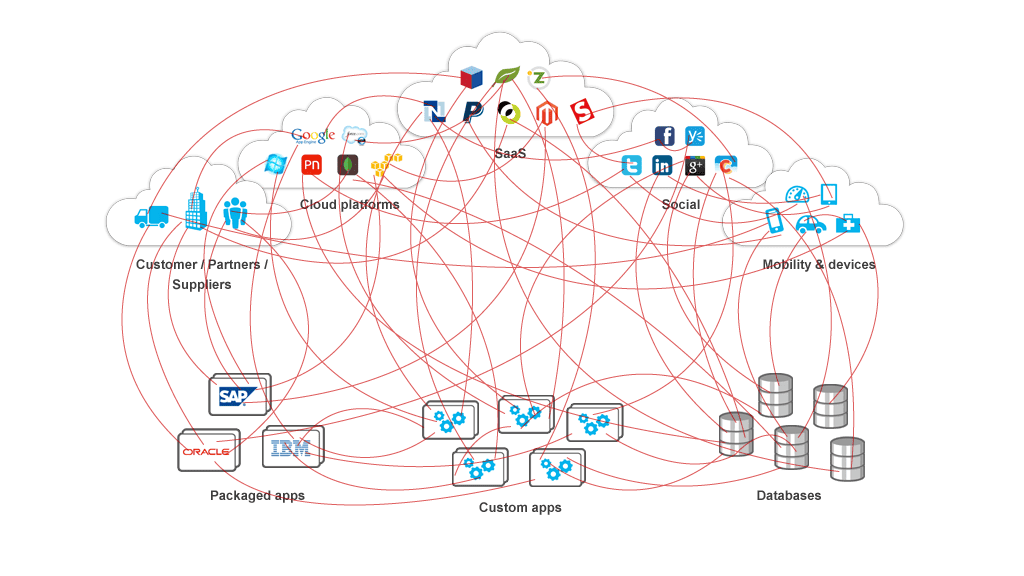From ETL tools to ESBs
In the IT landscape, ETL (extract, transform, load) processes have long been used for building data warehouses and enabling reporting systems. Using business intelligence (BI) oriented ETL processes, businesses extract data from highly distributed sources, transform it through manipulation, parsing, and formatting, and load it into staging databases. From this staging area data, summarizations, and analytical processes then populate data warehouses and data marts.
How ETL tools came to operational integration
Most certainly, ETL tools have their place in the IT environment, as numerous database admins utilize ETL tools to facilitate process and deliver optimal value to business.
- Data warehousing: Historically, the primary use for ETL tools has been to enable business intelligence. Pulling databases, application data and reference data into data warehouses provide businesses with visibility into their operations over time and enable management to make better decisions.
- Data integration: Data integration allows companies to migrate, transform, and consolidate information quickly and efficiently between systems of all kinds. ETL tools reduce the pain of manually entering data and allow dissimilar systems to communicate, all the while supplying a unified view.
The leading ETL tool, Informatica PowerCenter, has a long history in the data integration space. Its success can be attributed to its cross functionality, reusable components, and automatable processes. Optimized for moving large amounts of data in a batch-oriented manner, PowerCenter and similar ETL tools have been used to integrate enterprise applications across heterogeneous environments.
ETL tools for operational data integration
Operational databases house transactional data such as employee information, sales, customer feedback, and PoS information. These databases provide the foundation for the operational systems and applications that run the business. As operations increasingly required these systems to integrate with each other, existing ETL tools provided an obvious solution. Already supporting data-level connectivity to many popular databases and applications, ETL tools became a quick and seemingly simple means of connectivity and data movement. In a time when APIs were not as abundant, ETL tools were the go-to solution for operational use cases.
ETL tools get complicated
ETL tools indeed provide a method of communication between databases and applications, but pose significant challenges over time. Because creating this type of connectivity requires an comprehensive knowledge of each operational database or application, interconnectivity can get complicated as it calls for implementing very invasive custom integrations.
Over time, this approach grows increasingly complex, and the greater the number of interconnected systems, the more complicated things become. Moreover, with such tight coupling, interdependencies create the potential for big, unpredictable impacts when even the slightest changes are made. The custom point-to-point data-level integrations become a tangled web of brittle connections, quickly beginning to look like “spaghetti code”.

As the IT landscape transitions to the cloud, lack of visibility into the internals of cloud databases and applications often make it impossible to implement ETL-based integrations. Moreover, the transition to the cloud means greater value is placed on real-time integration updates, something ETL tools cannot easily deliver, as they are primarily batch-oriented.
APIs and ESBs simplify data integration
The increase in popularity of APIs has also made it much easier to create connectivity. With APIs, developers can access endpoints and build connections without having in-depth knowledge of the system itself, simplifying processes tremendously. As ETL tools remained focused more towards BI and big data solutions, and as traditional operational data integration methods become outdated with the rise in popularity of cloud computing, ESBs become better options to create connectivity.
An enterprise service bus (ESB) provides API-based connectivity with real-time integration. Unlike traditional ETL tools used for data integration, an ESB isolates applications and databases from one another by providing a middle service layer. This abstraction layer reduces dependencies by decoupling systems and provides flexibility. Developers can utilize pre-built connectors to easily create integrations without extensive knowledge of specific application and database internals, and can very quickly makes changes without fear of the entire integrated system falling apart. Shielded by APIs, applications and databases can be modified and upgraded without unexpected consequences. In comparison to utilizing ETL tools for operational integration, an ESB provides a much more logical and well defined approach to take on such an initiative.
MuleSoft provides an integration platform
MuleSoft offers an ESB solution to help businesses with their integration needs. Mule as an ESB is a component within Anypoint™ Platform. The next generation platform consists of a set of products that help businesses connect SaaS, cloud, mobile, and on-premises applications and services as well as data sources. Working with numerous other components, Anypoint Platform delivers a robust integration solution for businesses:
- DataWeave: A graphical data mapping solution that works with Mule as an ESB and Anypoint Studio (MuleSoft’s graphical design environment) to provide powerful data integration capabilities with an easy to use interface.
- Anypoint Connectors: Leveraging a library of Anypoint Connectors enables instant API connectivity to hundreds of popular applications and services, making it easy to extract and load data into popular sources and endpoints.
- Visual data mapping: A graphical interface eliminates the need for intricate manual coding. Simply use the graphical drag and drop interface of Anypoint Studio to accelerate development productivity.
- File type support: With support for flat and structured data formats such as XML, JSON, CSV, POJOs, Excel, and much more, organizations have flexibility over which data formats to use.
- Database-level connectivity: For cases where direct interaction to databases is required, MuleSoft’s Anypoint Connectors include options to connect to relational databases, as well as emerging Big Data platforms like MongoDB and Hadoop.
MuleSoft offers numerous solutions to help businesses overcome integration challenges and transform themselves into an efficient New Enterprise in which numerous disparate systems and applications can seamless communicate Typical ETL tools are limited in their ability to serve the requirements of the New Enterprise, but an enterprise service bus can provide real-time, high-performance, scalable operation capabilities. Learn more about Mule as an ESB, DataWeave, and Anypoint Platform by speaking to an expert today!



